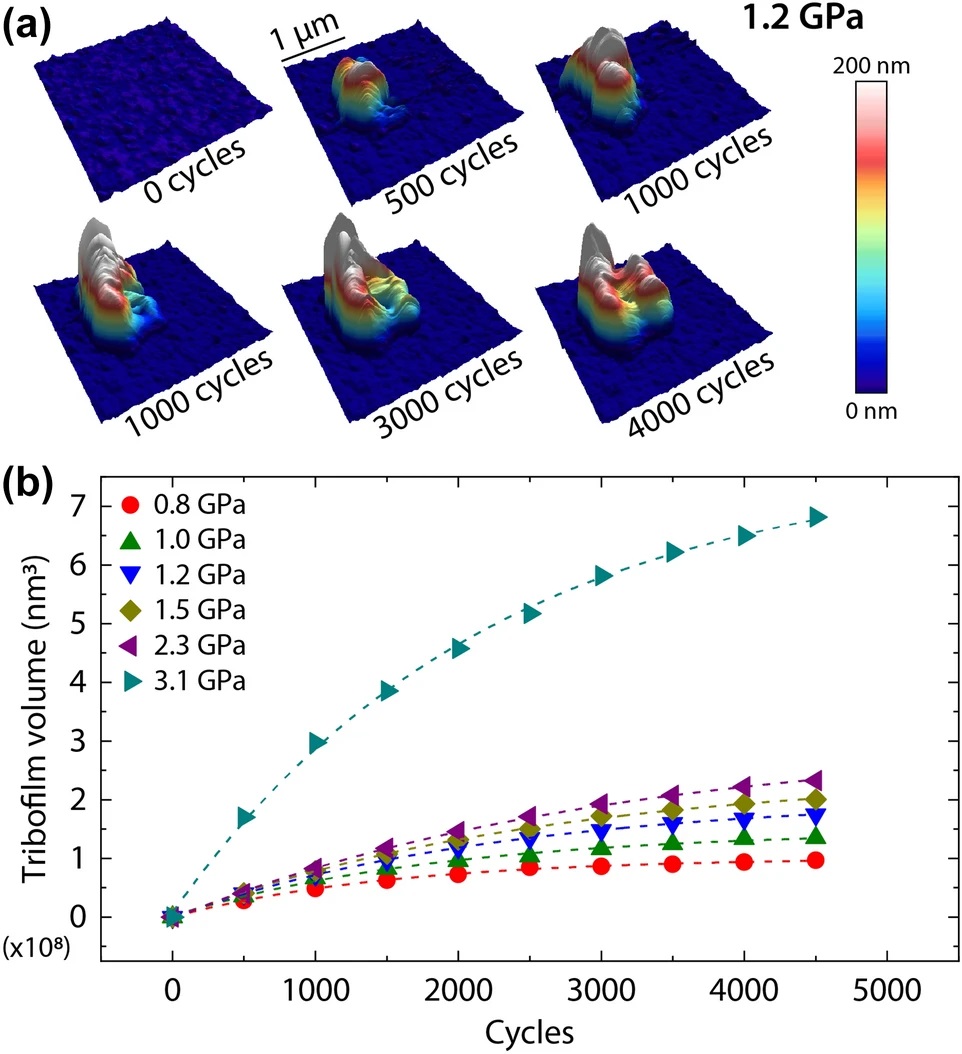Although catalysis is a popular explanation for tribopolymer generation, the interplay of catalysis, mechanochemistry, and electrostatic interactions remain incompletely understood. There is consensus, however, that the mechanisms for forming a frictional polymer in situ require at least three conditions: the presence of organics, a catalytically-active substrate, and shear between surfaces (i.e., sliding contacts). *
The formation of these highly lubricious tribofilms at low temperature from ambient hydrocarbon species is novel and of significant practical interest, given the simple requirements to activate the process. *
In their article “Stress- and Time-Dependent Formation of Self-Lubricating In Situ Carbon (SLIC) Films on Catalytically-Active Noble Alloys” Morgan R. Jones, Frank W. DelRio, Thomas E. Beechem, Anthony E. McDonald, Tomas F. Babuska, Michael T. Dugger, Michael Chandross, Nicolas Argibay and John F. Curry describe how low shear strength (30 MPa) organic films were grown in situ on Pt0.9Au0.1 surfaces via cyclic sliding contact in dry N2 with trace concentrations of ambient hydrocarbons. *
The nanocrystalline Pt0.9Au0.1 alloy (also termed a Pt-Au thin film in the article) used in their study is likely catalytically-active while exhibiting high hardness (~ 7 GPa) and exceptional wear resistance. *
They then continue to present a systematic investigation of the stress- and time-dependent film formation. *
Atomic force microscopy (AFM) was used to study the formation and growth of films at the nanoscale. *
The authors’ AFM experiments confirm the increase in surface coverage (volume) with pressure, but also highlight a transition from film growth to wear at a threshold contact pressure near 1.2 GPa. *
With time-dependent AFM experiments they demonstrate a sublinear increase in film volume with time, suggesting that the efficacy of the catalytic process decreased as the number of cycles increased. *
NANOSENSORS Diamond Coated PointProbe® Plus AFM probes of the DT-CONTR type were used for the nanoscale tribology experiments with Atomic Force Microscopy. *

Figure 5 from Morgan R. Jones et al. Stress- and Time-Dependent Formation of Self-Lubricating In Situ Carbon (SLIC) Films on Catalytically-Active Noble Alloys:
Tribofilm formation as a function of number of cycles as determined from the nanoscale experiments. (a) Intermittent-contact mode topography images (3 µm × 3 µm area) of the contact region at a contact pressure of 1.2 GPa after 0 cycles, 500 cycles, 1000 cycles, 2000 cycles, 3000 cycles, and 4000 cycles. (b) Tribofilm volume as a function of cycles for contact pressures up to 3.1 GPa. For all P, tribofilm volume increased asymptotically to a steady-state value at large numbers of cycles.
*Morgan R. Jones, Frank W. DelRio, Thomas E. Beechem, Anthony E. McDonald, Tomas F. Babuska, Michael T. Dugger, Michael Chandross, Nicolas Argibay and John F. Curry
Stress- and Time-Dependent Formation of Self-Lubricating In Situ Carbon (SLIC) Films on Catalytically-Active Noble Alloys
JOM The Journal of The Minerals, Metals & Materials Society (TMS), 73, pages 3658–3667 (2021)
DOI: https://doi.org/10.1007/s11837-021-04809-5
Please follow this external link to read the full article: https://rdcu.be/cPDfl
Open Access: The article “Stress- and Time-Dependent Formation of Self-Lubricating In Situ Carbon (SLIC) Films on Catalytically-Active Noble Alloys” by Morgan R. Jones, Frank W. DelRio, Thomas E. Beechem, Anthony E. McDonald, Tomas F. Babuska, Michael T. Dugger, Michael Chandross, Nicolas Argibay and John F. Curry is licensed under a Creative Commons Attribution 4.0 International License, which permits use, sharing, adaptation, distribution and reproduction in any medium or format, as long as you give appropriate credit to the original author(s) and the source, provide a link to the Creative Commons license, and indicate if changes were made. The images or other third party material in this article are included in the article’s Creative Commons licence, unless indicated otherwise in a credit line to the material. If material is not included in the article’s Creative Commons licence and your intended use is not permitted by statutory regulation or exceeds the permitted use, you will need to obtain permission directly from the copyright holder. To view a copy of this licence, visit http://creativecommons.org/licenses/by/4.0/.